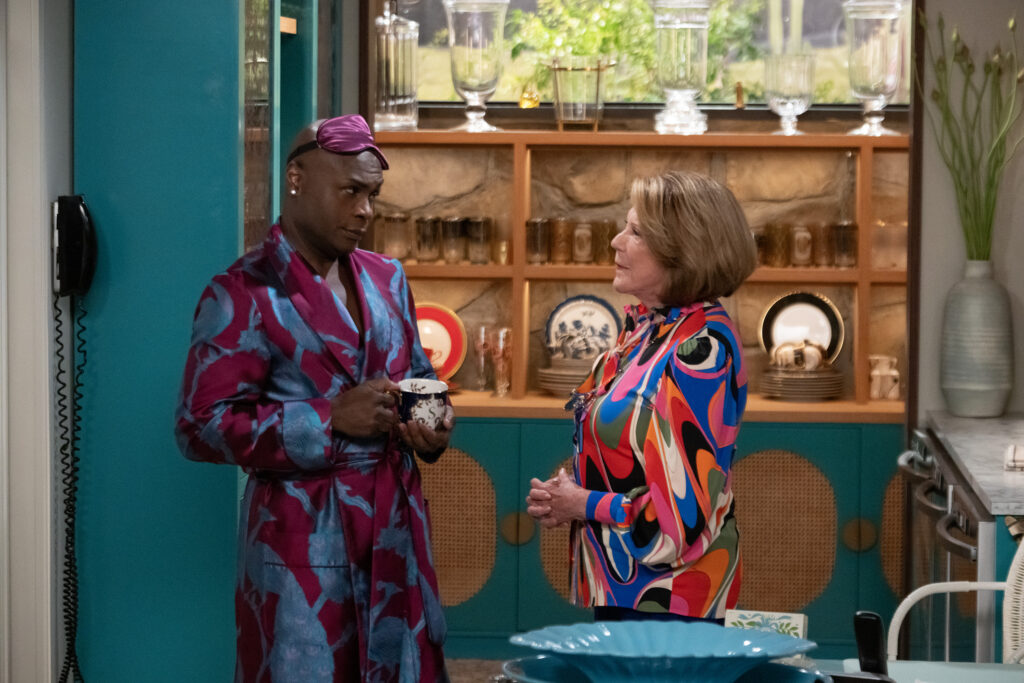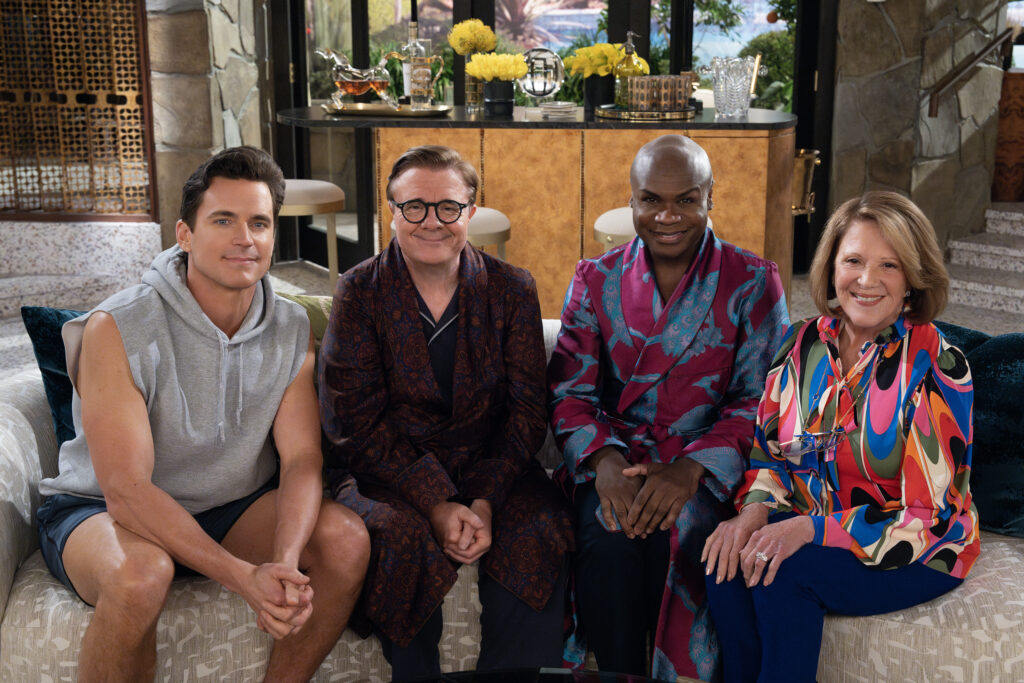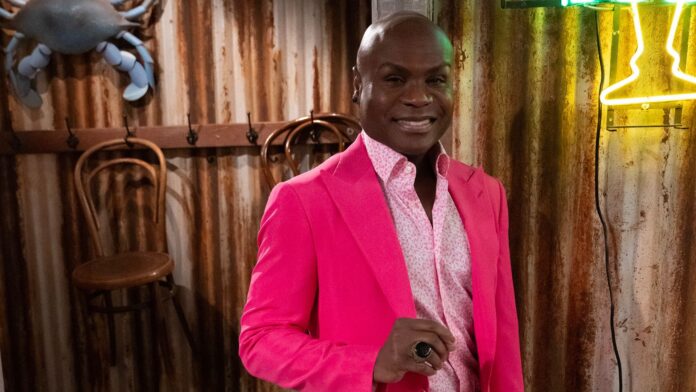The new comedy series “Mid-Century Modern,” debuting March 28 on Hulu, has three friends, bra store owner Bunny (Nathan Lane), ex-Mormon flight attendant Jerry (Matt Bomer), and former NYC fashion editor Arthur (Nathan Lee Graham), all living together in Palm Springs, along with Sybil (the late Linda Lavin), Bunny’s hypercritical Jewish mother.
The guys find living together has its challenges — as when all three men come down with COVID — but they also come to terms with their lives, search for love, and even take a trip back to Fire Island, where they first met. (A mutual friend’s death brings the trio back together).
The show, created by David Kohan and Max Mutchnick of “Will & Grace” fame, plays up the queer content and drops some F-bombs as the actors deliver broad performances and amusing one-liners. While Lane is comically flamboyant, and Bomer is adept at playing dumb, Graham steals every scene with his wit and wisdom.
In a recent interview, Graham chatted with PGN about making “Mid-Century Modern.”
Your character is both bitchy and the voice of reason. What can you say about playing Arthur?
I like to say that Arthur is “joyfully irritated.” Not being a bore and being more Auntie Mame and less Agnes Gooch is a good thing. Arthur would be rich if he lived in Iowa, but he lived in New York City, so he is ostensibly broke having lived a certain kind of life in New York City. I know a lot of people who have gone through the rollercoaster of life and can relate to the ups and downs of someone who has ambitions and sometimes not meeting those expectations or having something and then having it taken away from them and having to rebuild to start over again. Arthur is also a person who tells it like it is. We all need those people in life who bring us back to the center, to have balance. Even though he does it in sometimes a bitchy way, it is always with love. It is coming from a place where he actually cares, which is why he can tell you, in a loving way, that you suck. I so enjoy that. Nathan Lee Graham is a little bit like Arthur, but I certainly couldn’t get away with half of the things he says and does.
What can you say about creating the relationship dynamics with your costars?
Every family — chosen or biological — has these palace intrigue dynamics. There is a radius of love in the middle, and how you treat each person and play off each person depends upon what you need from them. The tactics are always slightly different with each character. The writers give us situations where we can play off each other. The comedy comes in layers; Jerry will piss Arthur off, and Bunny will piss Arthur off, and Sybil will spar with Arthur. We are equals, but we love each other. Everything is heightened because there can be a germ of truth to everything that is happening. You make it bigger to make it funnier.
These are older gay characters, so there is a frame of reference for their lived experiences, and I see they behave (or misbehave) accordingly. How do you think the show reinforced but also breaks down gay male stereotypes?
Things are generational. You try to learn. You try to pick up lingo and decode what is going on in the present day. But your past is your past. It is wonderful to have a TV show that brings up all that stuff and tries to work it out in this comedic way. Situation. Comedy. It is exciting to have these stories coming from people who are aging particularly from the LGBTQ+ community because that is not always seen on a world scale.
Arthur worked in fashion and dressed fabulously. What did you think of his outfits?
He gets to wear a Rick Owen’s bespoke travel cloak! Lori [Eskowitz-Carter] who is in charge of wardrobe, has an impeccable eye. Her attention to detail — particularly with men’s attire and Saville Row — is incredible and [so is] her understanding of fabrics and how they lay, and should be cut for the body, and how this costume will enhance this character. The wardrobe she pulls together lets the ensemble tell you what the story is or what will happen in this scene. I was doing a scene with Linda Lavin in the kitchen and Lori chose a more somber silk robe to indicate Arthur’s more somber attitude. It was nighttime, so I had more subdued colors, which Arthur had never worn before, which says to you that Arthur is in a different mood, a different place.
Do you have any observations about how the show addresses issues of race? There are a few times where it is overt and sometimes it is covert.
I think that’s what life is, isn’t it? Sometimes it’s very overt and sometimes it’s very covert, and I think the show reflects what happens in real life when it comes to race. They are not shying away from it in any way, shape or form. That I am on the show, and the way I am on it, with this well-rounded, fully fleshed-out, multi-dimensional character is a testament to how the writers envisioned this show to be. It is indicative of real life, and with my [personal] friend group is very reminiscent of “Mid-Century Modern.” Even if things are covert, the show circles around to let you know what we are talking about, and the audience can decide how they feel.

In one episode, Arthur says, “We are who we pretend to be.” What do you think about how Arthur in particular and gay men in general put on facades?
It’s called armor. If you are part of LGBTQ+ community or any marginalized community, there is certain armor we put on to make it through the day, to get through hopefully unscathed and protect ourselves. Putting on airs is a way to get through life because you are not accepted in all spaces or taught to be ashamed of yourself in some way. It is important to have that mechanism. Then, when you have the opportunity to be with real friends to be your full self, you can take off that armor.
What role do you think “Mid-Century Modern” will have in the pantheon of LGBTQ+ culture?
Any show that focuses on people being their authentic selves is historic in itself. Any show that says that everyone doesn’t fit into the same mold is historic. Especially when you are living in a time when to be yourself can be possibly threatening to people who want you to conform to be a certain way. If it makes you feel good about yourself, or you feel seen in any way, and that you exist and that you matter, these are all good and great things.


